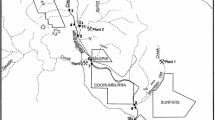Abstract
The geological setting and landuse activities of the Pimpama River catchment are typical for many drainage systems in southeast Queensland. The river originates in coastal ranges of Late Paleozoic age, crosses a floodplain developed during the Late Pleistocene-Holocene sea-level fluctuations and flows into the southern part of the Moreton Bay. The formation of sedimentary pyrite associated with the mid-Holocene transgression is an important feature of this coastal setting. The oxidation and hydrolysis of pyrite and the consequent production of sulfuric acid are controlled by the amount and seasonality of rainfall and influenced locally by landuse activities. The acid production and the leaching of dissolved metals from river alluvium and estuarine sediments impact substantially on land and aquatic habitats. The water quality of the Pimpama River and its tributaries reflects the lithology of the bedrock and can vary largely depending on season, tidal regimes, sediment lithology, local topography and agricultural activities.
Monitoring of river water for several seasons revealed four types of events, each with a different response in terms of water quality: (a) occasional showers during the dry season cause low pH and high amounts of dissolved metals in the water, (b) the first heavy rain of the wet season can produce very toxic conditions (low pH and high concentrations of metals) that can result in a fish kill, (c) towards the end of the wet season, prolonged flushing of pyrite oxidation products leads to short-term recovery of the aquatic system (neutral pH and lower amounts of dissolved metals in the water) and (d) a flood event can produce low pH, salinity and high concentrations of metals, which can represent lethal conditions for aquatic life. Assessment of saturation indexes for representative weathering and oxidation products such as clays, goethite, gibbsite and jarosite shows that these mineral phases can precipitate only when the water reaches neutral pH.
Similar content being viewed by others
Author information
Authors and Affiliations
Additional information
Received: 21 September 1998 · Accepted: 1 December 1998
Rights and permissions
About this article
Cite this article
Preda, M., Cox, M. Sediment–water interaction, acidity and other water quality parameters in a subtropical setting, Pimpama River, southeast Queensland. Environmental Geology 39, 319–329 (2000). https://doi.org/10.1007/s002540050011
Issue Date:
DOI: https://doi.org/10.1007/s002540050011




